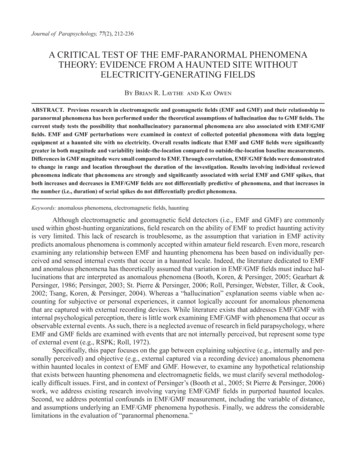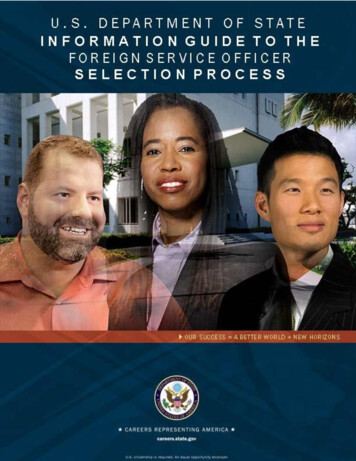
Transcription
Journal of Parapsychology, 77(2), 212-236A CRITICAL TEST OF THE EMF-PARANORMAL PHENOMENATHEORY: EVIDENCE FROM A HAUNTED SITE WITHOUTELECTRICITY-GENERATING FIELDSBy Brian R. Laythe and Kay OwenABSTRACT. Previous research in electromagnetic and geomagnetic fields (EMF and GMF) and their relationship toparanormal phenomena has been performed under the theoretical assumptions of hallucination due to GMF fields. Thecurrent study tests the possibility that nonhallucinatory paranormal phenomena are also associated with EMF/GMFfields. EMF and GMF perturbations were examined in context of collected potential phenomena with data loggingequipment at a haunted site with no electricity. Overall results indicate that EMF and GMF fields were significantlygreater in both magnitude and variability inside-the-location compared to outside-the-location baseline measurements.Differences in GMF magnitude were small compared to EMF. Through correlation, EMF/GMF fields were demonstratedto change in range and location throughout the duration of the investigation. Results involving individual reviewedphenomena indicate that phenomena are strongly and significantly associated with serial EMF and GMF spikes, thatboth increases and decreases in EMF/GMF fields are not differentially predictive of phenomena, and that increases inthe number (i.e., duration) of serial spikes do not differentially predict phenomena.Keywords: anomalous phenomena, electromagnetic fields, hauntingAlthough electromagnetic and geomagnetic field detectors (i.e., EMF and GMF) are commonlyused within ghost-hunting organizations, field research on the ability of EMF to predict haunting activityis very limited. This lack of research is troublesome, as the assumption that variation in EMF activitypredicts anomalous phenomena is commonly accepted within amateur field research. Even more, researchexamining any relationship between EMF and haunting phenomena has been based on individually perceived and sensed internal events that occur in a haunted locale. Indeed, the literature dedicated to EMFand anomalous phenomena has theoretically assumed that variation in EMF/GMF fields must induce hallucinations that are interpreted as anomalous phenomena (Booth, Koren, & Persinger, 2005; Gearhart &Persinger, 1986; Persinger, 2003; St. Pierre & Persinger, 2006; Roll, Persinger, Webster, Tiller, & Cook,2002; Tsang, Koren, & Persinger, 2004). Whereas a “hallucination” explanation seems viable when accounting for subjective or personal experiences, it cannot logically account for anomalous phenomenathat are captured with external recording devices. While literature exists that addresses EMF/GMF withinternal psychological perception, there is little work examining EMF/GMF with phenomena that occur asobservable external events. As such, there is a neglected avenue of research in field parapsychology, whereEMF and GMF fields are examined with events that are not internally perceived, but represent some typeof external event (e.g., RSPK; Roll, 1972).Specifically, this paper focuses on the gap between explaining subjective (e.g., internally and personally perceived) and objective (e.g., external captured via a recording device) anomalous phenomenawithin haunted locales in context of EMF and GMF. However, to examine any hypothetical relationshipthat exists between haunting phenomena and electromagnetic fields, we must clarify several methodologically difficult issues. First, and in context of Persinger’s (Booth et al., 2005; St Pierre & Persinger, 2006)work, we address existing research involving varying EMF/GMF fields in purported haunted locales.Second, we address potential confounds in EMF/GMF measurement, including the variable of distance,and assumptions underlying an EMF/GMF phenomena hypothesis. Finally, we address the considerablelimitations in the evaluation of “paranormal phenomena.”
A Critical Test of the EMF-Paranormal Phenomena TheoryEMF/GMF Thus Far in Haunted Locales213Previous research involving fluctuation of EMF/GMF has been strongly influenced by MichaelPersinger. The work by Persinger and his colleagues has demonstrated that low-level magnetic fields caninduce perceived “haunting phenomena” in laboratory settings (St. Pierre & Persinger, 2006). Laboratoryresearch demonstrated that application of 1 to 3 hertz magnetic fields applied to the parietal-temporal lobesproduced a “sensed presence” in about 80% of subjects (Booth et al., 2005). Per these researchers’ work,the sensed presence is described as “the personal proximity of a Sentient being, a presence, or ‘anotherconsciousness’” (St. Pierre & Persinger, 2006, p. 1080). These fields not only seem to facilitate hallucinations involving the presence of nearby entities but have also been shown to affect memory recall. Healeyand Persinger (2001) demonstrated that participants placed in a low-level EMF field reported 3 times asmany false memories when recalling a narrative as those who were not exposed to EMF. In the contextof both meta-analysis and multiple experiments (e.g., St. Pierre & Persinger, 2006), these researchers hypothesize that geomagnetic fields occurring naturally in certain locales might induce hallucinations thatcan account for haunting phenomena (Gearhart & Persinger, 1986). In essence, GMF-induced hallucinations may account for the bulk of what witnesses report as paranormal phenomena, and worse, may altermemory to create nonfactual memories in haunted locales.As a result of Persinger’s work, field research examining haunting sites has focused primarily on thepresence of abnormal EMF and GMF fields. Several researchers have demonstrated significantly differentdegrees of both field strength and variation between haunted and nonhaunted locales (Braithwaite, 2004,2006; Braithwaite, Perez-Aquino, & Townsend, 2004; Braithwaite & Townsend, 2005; Maher, 2000; Nichols & Roll, 1998; Roll & Persinger, 2001; Wiseman, Watt, Greening, Stevens, & O’ Keeffe, 2002; Wiseman, Watt, Stevens, Greening, & O’Keeffe, 2003). For instance, Nichols and Roll (1998) demonstratedEMF fields with Tri-Field meters that were significantly greater in areas of reported phenomena comparedto locations with no reports of phenomena. Wiseman et al. (2002) found that field strength and variance ofEMF/GMF were associated with the location where haunt experiences had been reported. Later researchby Wiseman et al. (2003) demonstrated significantly greater variation in EMF/GMF as a whole, but not inmagnitude. Braithwaite et al. (2004), with the use of the Magnetic Anomaly Detection System (MADS)which he designed, compared a “hot-spot” to a nonactive area. Their results demonstrated that GMF variability and magnitude were not only significantly different in a test and hot-spot area but also that fieldssignificantly varied during the investigation. In the above studies, Braithwaite and his colleagues werealso able to distinguish “pulses” or spikes of GMF that were significantly stronger than baseline readingsin the dataset. Of more detailed interest, Braithwaite et al. (2004) demonstrated both substantial magnitudeand variability effects within a one-room area and demonstrated that these EMF fields occurred in the 8to 10 hertz range.In context of Wiseman et al. (2002) and the findings of Braithwaite et al. (2004, 2006), a “fieldpicture” of EMF/GMF begins to take shape. In general, variability and magnitude of GMF/EMF appeargreater within haunted locales but vary over time and location within the site. What is essential with theabove studies is that external phenomena, such as recorded sounds or video, were not examined with anytype of EMF/GMF readings. Thus, the previous research suggests that “haunted” sites show greater variation in EMF/GMF fields than “un-haunted” sites. As a result of this variation in EMF and GMF, thesefields could account for such experiences as hallucinations (e.g., Braithwaite & Townsend, 2005) thatindividuals interpret as haunting phenomena.This leaves an entire area of haunting phenomena unexplored within an EMF/GMF hypothesis.Persinger’s research can account for almost any type of subjective (i.e., internally and personally perceived) haunting experiences. Likewise, previous research has demonstrated, at least in part, that EMF/GMF fields in haunted locales seem to fit conditions that could induce a Persinger effect due to variabilityin EMF/GMF fields (Braithwaite et al., 2004,). Where Persinger’s model does not fit, hypnagogic episodes(e.g., Cheyne, Newby-Clark, & Rueffer, 1999; Furuya et al., 2009; Kampanje, 2008; Sherwood, 2002) or
The Journal of Parapsychology214contagion effects (e.g., Hart et al., 2009; Lorber, Mazzoni, & Kirsch, 2007; Merckelbach, Van Roermund,& Candel, 2007; Peker & Tekcan, 2009) can account for other subjective haunting experiences due tosocial influence.However, what about those instances when anomalous phenomena occur and are documented withrecording devices? Amateur ghost hunting groups of all shapes and sizes report thousands of videos andaudio clips each year of allegedly anomalous phenomena. Although many of these events can be explainedwith careful evaluation, a percentage remains difficult to explain by conventional means. It follows thatif an anomalous event is captured on either audio or video, then this type of occurrence cannot be dueto a hallucination. Tradition in ghost hunting has maintained that EMF/GMF perturbation is associatedwith external phenomena. The purpose of the current research is to examine this particular claim aboveand beyond any events that are subjective and therefore could be due to Persinger fields or psychologicalconditions. Thus, the goal of the current research is to test if there is a simple association between objective phenomena (i.e., recorded phenomena of human-shaped entities, captured psychokinesis, or qualityelectronic voice phenomena) and EMF/GMF.Critical Issues in Testing the EMF/GMF Phenomena HypothesisIn order to examine a potential relationship between EMF and objective phenomena, it is essentialto examine several difficult issues involved in testing and sampling EMF and evaluating phenomena thatoccur. We have divided these issues and their potential confounds into three primary experimental concerns. First, we address the conditions regarding how EMF would theoretically perform in the context ofanomalous phenomena. Second, we discuss two variables related to EMF that have not been addressedby previous research—EMF vectors and fields—and the confound of distance. Finally, we attempt to dealwith the controversial issue of the evaluation of anomalous phenomena as “anomalous” as opposed toenvironmentally explainable events.The Hypothetical Nature of EMF/GMF in the Context of Paranormal Phenomena: Issues of Timeand OccurrenceGiven Braithwaite et al., (2004) and the findings of Wiseman et al. (2002, 2003), EMF/GMF fieldsare stronger and persistent within a haunted locale. These researchers’ findings also suggest that variability and magnitude of magnetic fields can change over time in small spaces. However, it is one thing todemonstrate that overall field magnitude will vary over time in a given area; it is a different thing to analyze EMF/GMF and phenomena that occur in the context of time. In order to test this type of relationship,certain assumptions must be made. First, while EMF/GMF fields change in magnitude and variability (e.g.Braithwaite et al., 2004), the current research makes no claims about the degree of variability, magnitude,or duration of EMF/GMF expected as a result of anomalous phenomena. The research of Braithwaite etal. (2004) indicates that individual spikes occurred during his measurement periods; however, the magnitude of these spikes was not large ( /-60 nT/.6 mG) and typically occurred for no longer than 0.5 seconds.Beyond the above researchers’ findings which do not address any type of anomalous objective event, noevidence exists to provide guidance on how these hypothesized field changes occur with anomalous phenomena.As such, to test openly an EMF/GMF phenomena hypothesis, small perturbations of EMF/GMFfields should be examined in detail. It is an assumption that large changes (positive or negative) in variability or magnitude occur in relation to anomalous phenomena. Frankly, this may not be the case. It isequally likely that small perturbations in EMF/GMF fields may predict anomalous phenomena. In eitherevent, data have not been examined to verify or rule out any of these claims.The Intervening Variables of EMF Fields, EMF Vectors and Distance, and Their Effects onMeasurementIn addition to the above issues that involve a lack of data regarding the EMF/GMF phenomena
215A Critical Test of the EMF-Paranormal Phenomena Theoryhypothesis, it is also the case that previous research has not addressed a fundamental confound involvingthe measurement of EMF/GMF fields. This confound involves the important variable of distance. Thedistance of a field, or the individual vector of a large field in relation to an EMF/GMF meter’s distance, iswhat determines the recorded measurement of magnitude (Tipler, 1987). However, the magnitude of thefield, and therefore its area of detectable effect, its location, and the number of other fields present willall affect the readings of a receptive EMF/GMF meter. What is crucial to understand is that the registeredstrength of a field decreases as a function of distance of the meter from the source of the field. In fact, thefield strength of EMF follows the inverse power law, which in terms of a meter’s detection of magnitudepractically decreases at a factor of about 10 per 1 foot of distance between the source of the field and themeter (Tipler, 1987).In a study in which anomalous phenomena are hypothesized to relate to EMF/GMF variation,specific EMF readings become problematic, as a researcher cannot reliably determine what is potentiallycausing a field, and more importantly, the specific location of its source. Because field sources are difficult to determine, it is never clear whether or not changes in EMF or GMF are due to singular or multiplefields or a large field vector. Likewise, if one entertains the possibility that these fields may be mobile orspontaneously generated (as is the tradition in haunting investigations), then location of a particular fieldin relation to the meter becomes even more problematic. Because specific location of an EMF field cannotbe easily determined, the specific output readings of EMF/GMF meters are substantially confounded bythe fact that the location of the EMF source cannot be determined, and therefore, the reading of a meter isgoing to change as a function of that distance. In essence, EMF/GMF changes recorded from a meter willvary as a function of the distance of the meter from the hypothesized field(s).As such, two important conditions exist in conducting research in which EMF/GMF is compared totime-dependent potentially anomalous events. First is the understanding that the sensitivity of the metersis crucial in their ability to detect a field as far as 6 to 8 ft away from a meter. This is part of the justificationfor examining small perturbations in EMF/GMF data around potential events. A small perturbation in thedata could theoretically represent a strong generated field as close as 10 feet away from the meter. The factthat the field is far away from the input source will weaken the received reading. As such, taking distanceinto account with EMF/GMF readings illuminates an important fact about EMF/GMF data measured ineither raw volt input, milligauss, or microteslas. Essentially, if the distance of the source of the EMF fieldis indeterminable, then both the increment of measurement and specific magnitude (in milligauss or microtesla) of the reading are useless aside from comparing a reading to the distributions that are collected.As the distance of the field from the meter (or frequency changes) will alter EMF/GMF magnitude, then aspecific magnitude reading is only approximate at best. Thus, field research of this design can only determine if an event produces readings that are significantly different from specific times and distributions ofthe collected EMF/GMF meter readings, but cannot provide accurate information about the actual strengthof the particular field that is being measured because of the confounding variables of distance and location.Collecting the Observable: Observable Anomalous Events, Their Evaluation and InterpretationOne of the fundamental problems in a research project of this nature involves the anomalous evidence collected. When anomalous events are hypothesized to be related to EMF/GMF fields, the bulkof critique falls on a critical approach to the operational definition of an anomalous event. Whereas EMFfields can be measured in context of the equipment used to detect it, heated debate can occur over whethera particular captured event can be reliably viewed as paranormal or anomalous.Research in social and cognitive psychology provides good reason for individuals to be skepticalof both subjective and objective anomalous evidence. In terms of the personally experienced events thatare reported at haunted locations, the demonstrated effects of Persinger fields (Gearhart & Persinger,1986; St. Pierre & Persinger, 2006) or hypnagogic hallucination episodes of perceived phenomena aroundsleep (Cheyne, Newby-Clark, & Rueffer, 1999; Furuya et al., 2009; Kampanje, 2008; Sherwood, 2002)make certain personal events very suspect in terms of their anomalous origins.
216The Journal of ParapsychologyHowever, the effects of Persinger fields and hypnagogic episodes can be controlled by simplymandating that the criterion for objective evidence must be recorded by either audio or video devices. But,objective events are still subject to interpretation, which leads investigators toward several cognitive biases. For instance, contagion effects can change memories (Merklebach, Van Roermund, & Candel, 2007),as well as emotions and behavior (Barsade, 2002), and create stronger biases when individuals are familiarwith each other (Peker & Tekcan, 2009). Any of these effects could create bias in qualifying an anomalousevent, even when recorded on audio or video. Likewise, research in belief perseverance (Lepper, Ross,& Lau, 1986; Ross, Lepper, & Hubbard, 1975) demonstrates a tendency for people to persist in beliefs inthe face of contradictory information. Thus, cues indicating the likelihood of an anomalous event can beignored if contrary to previous information or beliefs. Similarly, confirmation bias (Drake, 1983; O’Brien,2009)—the tendency to remember and prefer information that supports one’s existing beliefs—can alsoeasily confound the assessment of evidence.For the sake of the current research, and in a Popperian vein (e.g., Amini & Caldwell, 2010;Machado & Silva, 2007), we suggest that there is never a situation in which an anomalous event is considered fully proven as paranormal. Instead, it seems more scientifically reasonable to claim that someevents are much more likely (in terms of probability) to be anomalous compared to other events. However,while physical objective evidence may stand “as is” with human perception, there is always the concern ofinterpretation. To minimize effects of belief perseverance and confirmation bias, a consistent set of criteriashould be used to rate each event as either very unlikely to be paranormal or very likely to be paranormal.Consistently applied, this set of rules, while not definitive, reduces the likelihood that an individual investigator will accept evidence as anomalous that can be easily explained.The criteria should involve minimum requirements by which an investigator can rule out an eventdue to environmental or psychological factors. It should also contain criteria that make an event morepersuasive in terms of its paranormal validity, such as phenomena that can be perceived as a repeatedintelligen
Journal of Parapsychology, 77(2), 212-236 A CRITICAL TEST OF ThE EMF-PARANORMAL PhENOMENA ThEORy: EVIDENCE FROM A hAUNTED SITE WIThOUT ELECTRICITy-GENERATING FIELDS By Brian R. laythe and Kay Owen ABSTRACT. Previous research in electromagnetic and g











